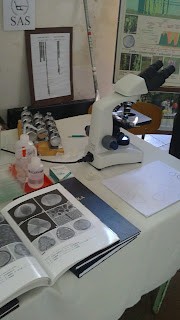Last week I went for a trip near of my hometown - Konin to find some medieval monuments. I chose to go 20 kilometeres to the north, to Kleczew, town which has preserved medieval urban layout. However there are no medieval buildings except gothic Saint Andrew the Apostle Church.
 |
| Saint Andrew the Apostle Church. |
Kleczew derives its name from Old-Polish word kiełek/kielek which can be translated in English as sprout, very young plant. In almost all sources we can find information that Kleczew was located 12th January 1366 under the Magdeburg rights (in Latin: Ius municipale magdeburgense, in German: Magdeburger Recht) and was founded by its owner Janek (in English: John). This fact is questionable because of the Kleczewian parish erection which had its place inn 12th century. Some sources even mention about the exact date of this event, about the year 1120. Certainly Kleczew had existed before 1366 but after that it could have been completely rebuilt, as it became magdeburgium.
In the medieval times Kleczew was a small settlment which was situated on the crossroads of the trade routes: from Greater Poland Province to Mazovia Province (west-east direction) and from Silesia Province to Pomerania Province (south-north direction). Thus the town was getting richer. The best indicator of this fact are sources which say about the participation of Kleczew in the Thirteen Years' War (in German: Dreizehnjähriger Krieg, in Polish: Wojna trzynastoletnia) between Kingdom of Poland (allied with Prussian Confederation) and State of the Teutonic Order 1454-1466. The town sponsored, armed and sent ten soldiers to the war. In the same time Poznan, which was the capital city of Greater Poland Province, supplied royal army with only sixty soldiers. I do not know what kind of soldiers Kleczew and Poznan sent to the war. Sources mention them using Polish word zbrojny which means armed. Those could have been both knights or infrantrymen.
Saint Andrew the Apostle Church was built in 12th century and it was made of wood. In the second part of 14th century it was rebuilt into gothic style in the shape of hall church. This time it was made of stones and bricks. The oldest part of the building nowadays functions as presbytery. The church had three naves (one main and two secondary) they were added at the beginning of 16th century. The porch is the youngest part of the building. Sources say that it was built in the 19th century.
 |
| View from the east, presbytery. |
|
|
|
|
|
|
 |
| Northern wall of the nave with bricked up entrance. |
 |
| North-western corner of the nave. |
 |
| North-eastern corner of the church with added outbuilding to the northern wall of the presbytery. |
 |
| View from the west, porch. |
 |
| South-western corner of the nave. |
 |
| Southern wall of the nave with entrance. |
 |
| South-eastern corner of the church, presbytery. |
 |
| Small, almost completely bricked up window, near the porch. |
Key words: town, miasto, ciudat, горад,
miests, град, grad, mjesto, ciutat, město, by,
stadt, πόλη, linn, ciudad, kaupunki, cathair, város, borg, miestas,
urbs, ville, città, oraș, pilsēta, cidade, qyteti, mesto, stad, şehir, город, mjasto, місто, church, kościół, ilesia, bažnīčė,
царква, храм, църква, crkva, església, kostel, eglwys, kirke, kirche,
χριστιανικός ναός, iglesia, kirik, kirkko, kirkja, église, tsjerke, eaglais,
igrexa, chiesa, kirch, ecclesia, kierch, bažnyčia, baznīca, црква,
kerkgebouw, kerk, kyrkje, égllise, glèisa, kaerich, igreja, biserică, церковь,
церьков, kirk, girku, kostol, cerkev, kisha, kyrka, kośćůł, eliza, kark, kaark,
kilise, церква, céxa.
























.JPG)
.JPG)


